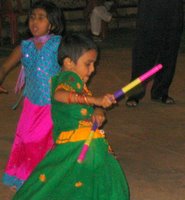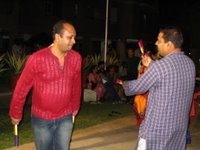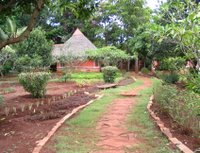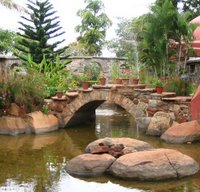Dasara
Dasara, also known as Navaratri, is a nine day celebration of good over evil. In Hindu mythology, the story of Lord Rama triumphing over the demon Ravana is the basis of this holiday.
Last week, some of the ladies in our apartment complex decided to celebrate right here in our own back yard. There was to be food, music and dance. Helen was invited and participated each afternoon in the dance rehearsals. As a special treat, three women who are skilled in the art of applying henna to women’s hands were
back yard. There was to be food, music and dance. Helen was invited and participated each afternoon in the dance rehearsals. As a special treat, three women who are skilled in the art of applying henna to women’s hands were  invited in on Thursday to henna the hands of all the dancers, including all the little girls. Helen has become acquainted with Nimi (above) and asked her how many times she’d had her hands henna-ed. “Only once; for my marriage,” was her reply, so now she was getting it done again and her nine year old daughter was having it done as well!
invited in on Thursday to henna the hands of all the dancers, including all the little girls. Helen has become acquainted with Nimi (above) and asked her how many times she’d had her hands henna-ed. “Only once; for my marriage,” was her reply, so now she was getting it done again and her nine year old daughter was having it done as well!
 Friday was the big night. All the children were dressed up; the girls in glittery skirts and tops with ha
Friday was the big night. All the children were dressed up; the girls in glittery skirts and tops with ha ir jewelry and bracelets and the boys in their kurta pajamas.
ir jewelry and bracelets and the boys in their kurta pajamas.
The women were wearing special saris and gold jewelry with colored gemstones that matched the color of their saris. These saris originated in the state of  triangles or bigger squares. Helen borrowed a green and goldish brown bandhini sari, a petticoat with a drawstring to hold it up (which was tied quite tightly around the waist), and another woman gave me a few of her bracelets to wear. Her hands were too big to fit through most of the bracelets she had.
triangles or bigger squares. Helen borrowed a green and goldish brown bandhini sari, a petticoat with a drawstring to hold it up (which was tied quite tightly around the waist), and another woman gave me a few of her bracelets to wear. Her hands were too big to fit through most of the bracelets she had.
The first performers were a group of about 10 girls, ages 4-7, who did a little dance that was fun to watch. The next group of girls was about 8-12 years old and performed some classical Indian dance moves combined with some tr aditional dance. The third group was about 30 children, boys and girls, who danced to a well-known song. The women were the last to come. On a large slab of concrete in the play area, we danced with partners in a big circle at one end and the children did the same dance at the other end. Near the end of the dance the children came inside the circle of women, everyone clicking their sticks, and it ended with a big, “Hurrah!” Srimati (left) was my partner.
aditional dance. The third group was about 30 children, boys and girls, who danced to a well-known song. The women were the last to come. On a large slab of concrete in the play area, we danced with partners in a big circle at one end and the children did the same dance at the other end. Near the end of the dance the children came inside the circle of women, everyone clicking their sticks, and it ended with a big, “Hurrah!” Srimati (left) was my partner.

The women performed the traditional Indian dance using sticks, which is done only to celebrate Dasara. The dads and grandparents watching were so impressed that they asked for a repeat performance so everybody got to dance twice!
 When it was all over, it was still early and nobody was ready to go home. The DJ put on some current Indian music. The first one was a song that had a video with Bollywood dancers and there were a couple of 10 year olds who knew all the moves by heart, so the rest of the kids followed along. Next came some American hip hop and
When it was all over, it was still early and nobody was ready to go home. The DJ put on some current Indian music. The first one was a song that had a video with Bollywood dancers and there were a couple of 10 year olds who knew all the moves by heart, so the rest of the kids followed along. Next came some American hip hop and rap and by the time the moms and a few of the dads were done dancing (the women danced with women and the men danced with other men), it was time to pack up and head back to the apartment. All in all it was a fun night.
rap and by the time the moms and a few of the dads were done dancing (the women danced with women and the men danced with other men), it was time to pack up and head back to the apartment. All in all it was a fun night.























